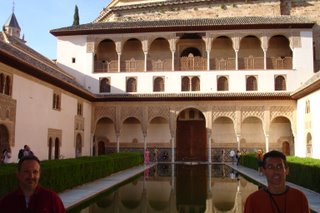

Today was our last day in Spain. We travelled from Barcelona, Spain to France to Spain to Andorra and to Toulouse, France. Three countries, five cities and 602km - all in one day. This is Europe for you. The beach in the background of the top photo is the site (Empuries, 160km north of Barcelona) where the ancient Greeks first reached the Iberian Peninsula back around 500BC and the place where Irene Pappas (famous Greek actress) handed the Olympic flame from a boat to the Spanish for the 1992 Olympics.
The other photo is the city of Andorra La Vella (pop 23,000), capital of the country Andorra (pop 71,000), a small independent principality in the Pyrénées Mountains which border France and Spain. Mountains and ski resorts everywhere, reaching heights to 2,942m over a 20 by 20km area.
Our last stop in Spain before Andorra was the Salvador Dali musuem and grave in Figueres (pop 35,000). Dali lived 1904-1989 and was very eccentric.
Adios Espana. Some observations as we look back: not much freshly squeezed orange juice (so much is exported), people do not speak much English or do not like doing so, pedestrian crossings "chirp" like a bird, very cheap strawberries, shorts are not widely worn until 24 June when summer officially starts, metro in Madrid comes every 3min, city underground car parks are automated (green lights show you available spots, how many and where) and the big fact: Spain is under re-construction: there are roadworks, buildings and other major works in every city, no matter the size! Total distance so far: 7,479km. See you back in France, starting in Toulouse with the A380!














































